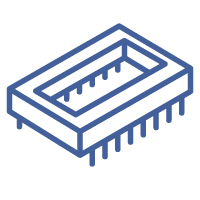
Advanced Energy AVQ400-48S12B-4L
AVQ400-48S12B-4L
0402 (1005 Metric)
37090915-AVQ400-48S12B-4L
Module DC-DC 1-OUT 12V 33(Max)A 400W Through Hole 5-Pin Quarter-Brick
- Mounting TypeSurface Mount, MLCC
- Package / Case0402 (1005 Metric)
- Lead Free Status / RoHS StatusLead free / RoHS Compliant
- Voltage Rated
RATED voltage is the voltage on the nameplate - the "design point" for maximum power throughput and safe thermal operation.
25V - Supplier PackageQuarter-Brick
- Switching RegulatorYes
- MountingThrough Hole
- Operating Temperature
The operating temperature is the range of ambient temperature within which a power supply, or any other electrical equipment, operate in. This ranges from a minimum operating temperature, to a peak or maximum operating temperature, outside which, the power supply may fail.
-55°C ~ 150°C - SeriesGA
- Packaging
Semiconductor package is a carrier / shell used to contain and cover one or more semiconductor components or integrated circuits. The material of the shell can be metal, plastic, glass or ceramic.
Tape & Reel (TR) - Size / Dimension0.039 L x 0.020 W (1.00mm x 0.50mm)
- Tolerance±5%
- Moisture Sensitivity Level (MSL)1 (Unlimited)
- Temperature Coefficient
The resistance-change factor per degree Celsius of temperature change is called the temperature coefficient of resistance. This factor is represented by the Greek lower-case letter “alpha” (α). A positive coefficient for a material means that its resistance increases with an increase in temperature.
X7R - TypeStep Down
- ApplicationsAutomotive
- Capacitance4700pF
- Pin Count
a count of all of the component leads (or pins)
5 - Number of Outputs1
- Output Voltage12 V
- Failure Rate
the frequency with which an engineered system or component fails, expressed in failures per unit of time. It is usually denoted by the Greek letter λ (lambda) and is often used in reliability engineering.
- - Lead Spacing
the distance between two baselines of lines of type. The word 'leading' originates from the strips of lead hand-typesetters used to use to space out lines of text evenly. The word leading has stuck, but essentially it's a typographer's term for line spacing.
- - Output Current
The rated output current is the maximum load current that a power supply can provide at a specified ambient temperature. A power supply can never provide more current that it's rated output current unless there is a fault, such as short circuit at the load.
33 A - Lead Style-
- Output Power
That power available at a specified output of a device under specified conditions of operation.
400 W - Features-
- Input Voltage36 to 75 V
- Height Seated (Max)-
- Thickness (Max)0.024 (0.60mm)
- RatingsAEC-Q200








